Electromagnetic Field Tests of a 1-MW Wireless Power Transfer System for Light Rail Transit
Abstract
1. Introduction
2. International Guidelines on EMF and EMI
2.1. EMF Guidelines
2.2. EMI Guidelines
3. WPT System for Light Rail Transit
3.1. Overview of WPT System for Light Rail Transit
3.2. Structure of the Power Line and Pick-Up
3.3. Analysis of Electric Field by Simulation
4. Measurement Results of EMF and EMI
4.1. EMF Measurement Results
4.2. EMI Measurement Results
5. Conclusions
Author Contributions
Funding
Institutional Review Board Statement
Informed Consent Statement
Conflicts of Interest
References
- Midya, S.; Bormann, D.; Schutte, T.; Thottappillil, R. Pantograph arcing in electrified railways—Mechanism and influence of various parameters—Part I: With DC traction power supply. IEEE Trans. Power Del. 2009, 24, 1931–1939. [Google Scholar] [CrossRef]
- Song, Y.; Liu, Z.; Rønnquist, A.; Nåvik, P.; Liu, Z. Contact wire irregularity stochastics and effect on high-speed railway pantograph–catenary interactions. IEEE Trans. Instrum. Meas. 2020, 69, 8196–8206. [Google Scholar] [CrossRef]
- Zhang, B.; Carlson, R.B.; Smart, J.G.; Dufek, E.J.; Liaw, B. Challenges of future high-power wireless power transfer for light-duty electric vehicles—technology and risk management. eTransportation 2019, 6, 100088. [Google Scholar] [CrossRef]
- Song, K.; Koh, K.E.; Zhu, C.; Jiang, J.; Wang, C.; Huang, X. A Review of dynamic wireless power transfer for in motion electric vehicles. Wirel. Power Transf. 2016, 109–128. [Google Scholar] [CrossRef]
- Obayashi, S.; Shijo, T.; Suzuki, M.; Moritsuka, F.; Ogawa, K.; Ogura, K.; Kanekiyo, Y.; Ishida, M.; Takanaka, T.; Tada, N.; et al. 85 kHz band 44 kW wireless rapid charging system for field test and public road operation of electric bus. World Electr. Veh. J. 2019, 10, 26. [Google Scholar] [CrossRef]
- Elliott, G.A.J.; Covic, G.A.; Kacprzak, D.; Boys, J.T. A new concept: Asymmetrical pick-ups for inductively coupled power transfer monorail systems. IEEE Trans. Magn. 2006, 42, 3389–3391. [Google Scholar] [CrossRef]
- Brecher, A.; David, A. Review and Evaluation of Wireless Power Transfer (WPT) for Electric Transit Applications; No. FTA Report No. 0060; John, A., Ed.; Volpe National Transportation Systems Center: Cambridge, MA, USA, 2014. [Google Scholar]
- Winter, J.; Mayer, S.; Kaimer, S. Inductive power supply for heavy rail vehicles. In Proceedings of the 3rd International Electric Drives Production Conference (EDPC), Nuremberg, Germany, 29–30 October 2013; pp. 1–9. [Google Scholar] [CrossRef]
- Kim, J.H.; Lee, B.-S.; Lee, J.-H.; Lee, S.-H.; Park, C.-B.; Jung, S.-M.; Lee, S.-G.; Yi, K.-P.; Baek, J. Development of 1-MW inductive power transfer system for a high-speed train. IEEE Trans. Ind. Electron. 2015, 62, 6242–6250. [Google Scholar] [CrossRef]
- Ukita, K.; Kashiwagi, T.; Sakamoto, Y.; Sasakawa, T. Evaluation of a non-contact power supply system with a figure-of-eight coil for railway vehicles. In Proceedings of the 2015 IEEE PELS Workshop on Emerging Technologies: Wireless Power (2015 WoW), Daejeon, Korea, 5–6 June 2015. [Google Scholar] [CrossRef]
- Campi, T.; Cruciani, S.; Santis, V.D.; Maradei, F.; Feliziani, M. EMC and EMF safety issues in wireless charging system for an electric vehicle (EV). In Proceedings of the International Conference of Electrical and Electronic Technologies for Automotive, Torino, Italy, 15–16 June 2017. [Google Scholar] [CrossRef]
- Jeschke, S.; Maarleveld, M.; Baerenfaenger, J.; Schmuelling, B.; Burkert, A. Challenges in EMC testing of EV and EVSE equipment for inductive charging. In Proceedings of the International Symposium on Electromagnetic Compatibility (EMC EUROPE), Amsterdam, The Netherlands, 27–30 August 2018. [Google Scholar] [CrossRef]
- Zhang, W.; White, J.C.; Malhan, R.K.; Mi, C.C. Loosely coupled transformer coil design to minimize EMF radiation in concerned areas. IEEE Trans. Veh. Technol. 2016, 65, 4779–4789. [Google Scholar] [CrossRef]
- Yashima, Y.; Omori, H.; Morizane, T.; Kimura, N.; Nakaoka, M. Leakage magnetic field reduction from wireless power transfer system embedding new eddy current-based shielding method. In Proceedings of the International Conference on Electrical Drives and Power Electronics (EDPE), The High Tatras, Slovakia, 21–23 September 2015. [Google Scholar] [CrossRef]
- Shijo, T.; Ogawa, K.; Suzuki, M.; Kanekiyo, Y.; Ishida, M.; Obayashi, S. EMI reduction technology in 85 kHz band 44 kW wireless power transfer system for rapid contactless charging of electric bus. In Proceedings of the IEEE Energy Conversion Congress and Exposition (ECCE), Milwaukee, WI, USA, 18–22 September 2016. [Google Scholar] [CrossRef]
- Song, B.; Dong, S.; Gao, X.; Li, Y.; Cui, S. A tripolar wireless power transfer system with low leakage magnetic field for railway vehicles. In Proceedings of the 21st European Conference on Power Electronics and Applications (EPE′19 ECCE Europe), Genova, Italy, 2–5 September 2019. [Google Scholar] [CrossRef]
- Asa, E.; Mohammad, M.; Onar, O.C.; Pries, J.; Galigekere, V.; Su, G.-J. Review of safety and exposure limits of electromagnetic fields (EMF) in wireless electric vehicle charging (WEVC) applications. In Proceedings of the IEEE Transportation Electrification Conference & Expo (ITEC), Chicago, IL, USA, 22–26 June 2020. [Google Scholar] [CrossRef]
- Mohamed, A.A.S.; Meintz, A.; Schrafel, P.; Calabro, A. Testing and assessment of EMFs and touch currents from 25-kW IPT system for medium-duty EVs. IEEE Trans. Veh. Technol. 2019, 68, 7477–7487. [Google Scholar] [CrossRef]
- Kim, M.; Kim, H.; Kim, D.; Jeong, Y.; Park, H.-H.; Ahn, S. A three-phase wireless-power-transfer system for online electric vehicles with reduction of leakage magnetic fields. IEEE Trans. Microw. Theory Tech. 2015, 63, 3806–3813. [Google Scholar] [CrossRef]
- Mohammad, M.; Wodajo, E.T.; Choi, S.; Elbuluk, M.E. Modeling and design of passive shield to limit EMF emission and to minimize shield loss in unipolar wireless charging system for EV. IEEE Trans. Power Electron. 2019, 34, 12235–12245. [Google Scholar] [CrossRef]
- Choi, S.Y.; Gu, B.W.; Lee, S.W.; Lee, W.Y.; Huh, J.; Rim, C.T. Generalized active EMF cancel methods for wireless electric vehicles. IEEE Trans. Power Electron. 2013, 29, 5770–5783. [Google Scholar] [CrossRef]
- Cruciani, S.; Campi, T.; Maradei, F.; Feliziani, M. Wireless charging in electric vehicles: EMI/EMC risk mitigation in pacemakers by active coils. In Proceedings of the IEEE PELS Workshop on Emerging Technologies: Wireless Power Transfer (WoW), London, UK, 17–27 June 2019. [Google Scholar] [CrossRef]
- Ahlbom, A.; Bergqvist, U.; Bernhardt, J.H.; Cesarini, J.P.; Court, L.A.; Grandolfo, M.; Hietanen, M.; McKinlay, A.F.; Repacholi, M.H.; Sliney, D.H.; et al. Guidelines for limiting exposure to time-varying electric, magnetic, and electromagnetic fields (up to 300 GHz). Health Phys. 1998, 74, 494–521. [Google Scholar]
- International Commission on Non-Ionizing Radiation Protection. Guidelines for limiting exposure to time-varying electric and magnetic fields (1 Hz to 100 kHz). Health Phys. 2010, 99, 818–836. [Google Scholar] [CrossRef]
- International Standard. Magnetic Field Levels Generated by Electronic and Electrical Apparatus in the Railway Environment with Respect to Human Exposure–Measurement Procedures; IEC 62597; American National Standards Institute (ANSI): New York, NY, USA, 2019. [Google Scholar]
- International Standard. Railway Applications–Electromagnetic Compatibility–Part 2: Emission of the Whole Railway System to the Outside World; IEC 62236-2; American National Standards Institute (ANSI): New York, NY, USA, 2018. [Google Scholar]
- International Standard. Railway Applications–Electromagnetic Compatibility–Part 3-1: Rolling Stock–Train and Complete Vehicle; IEC 62236-3-1; American National Standards Institute (ANSI): New York, NY, USA, 2018. [Google Scholar]

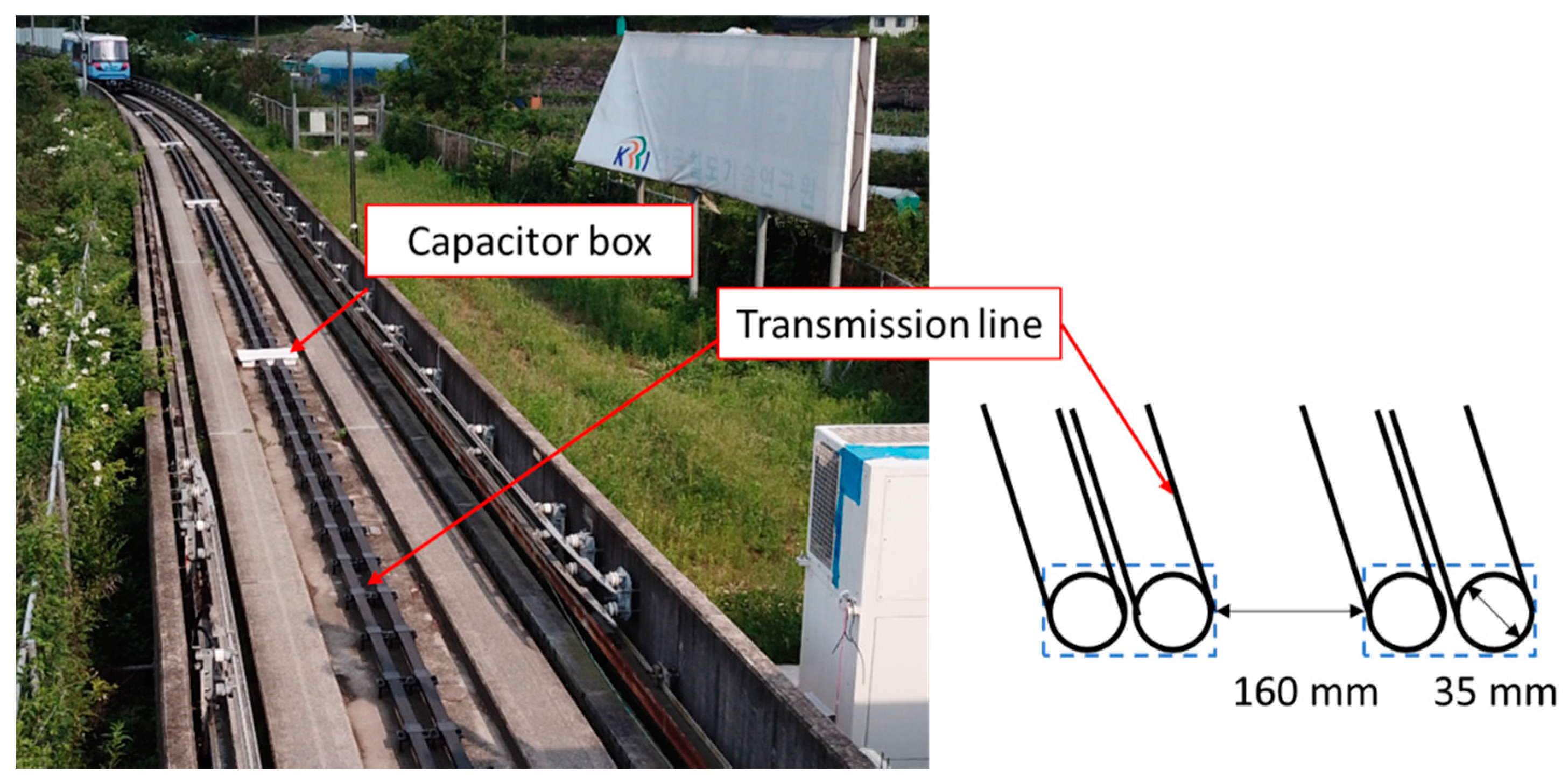
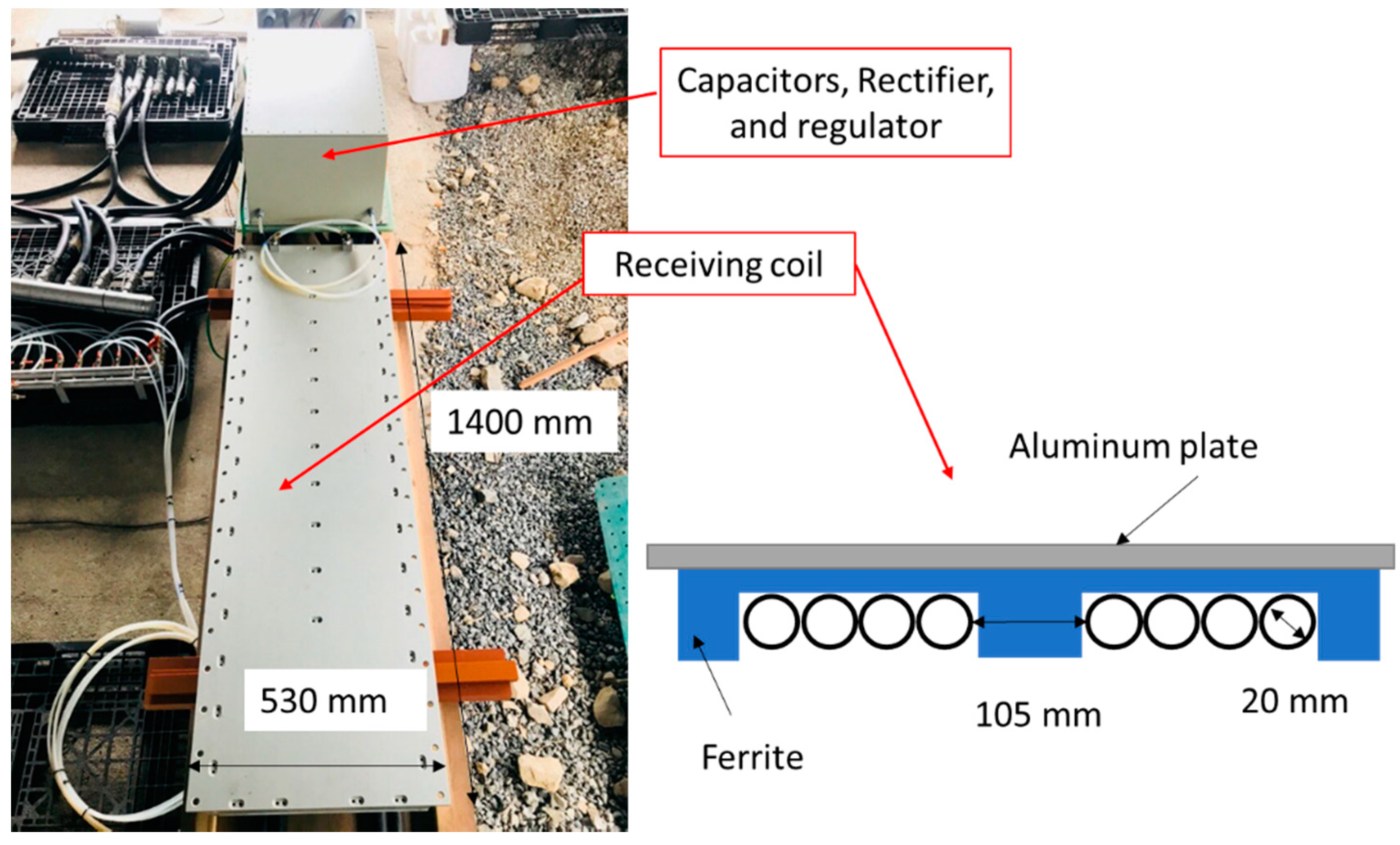
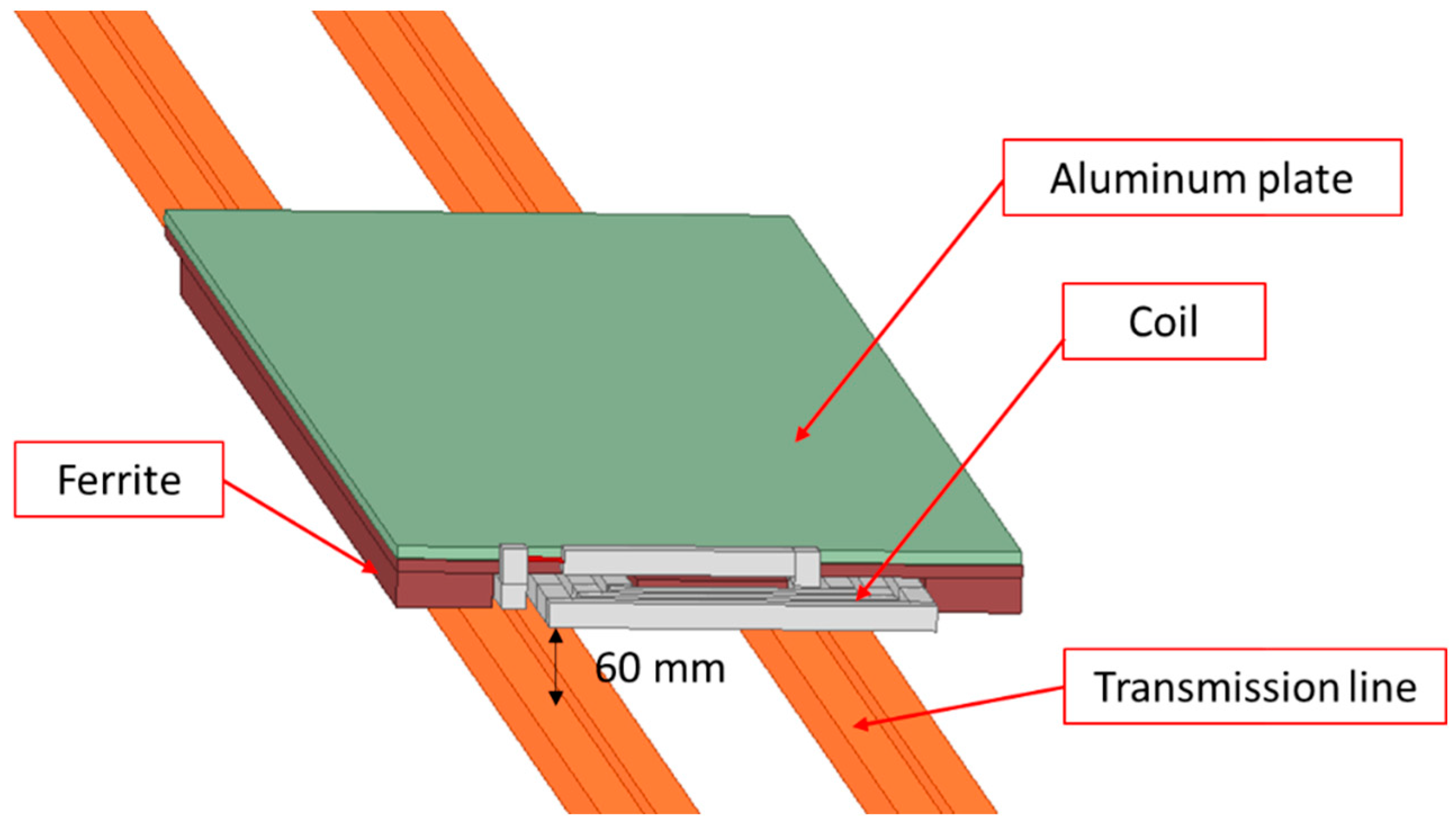
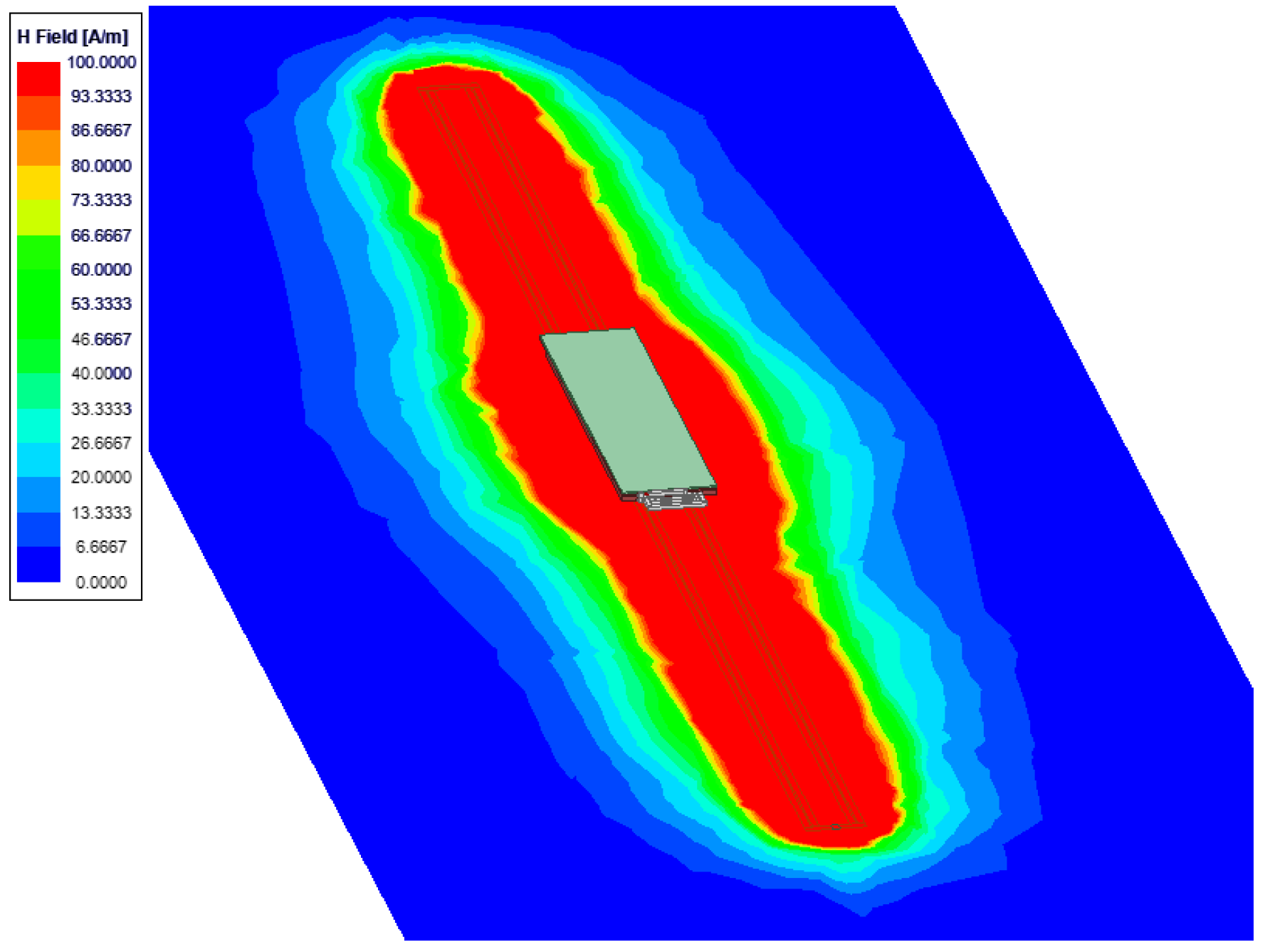
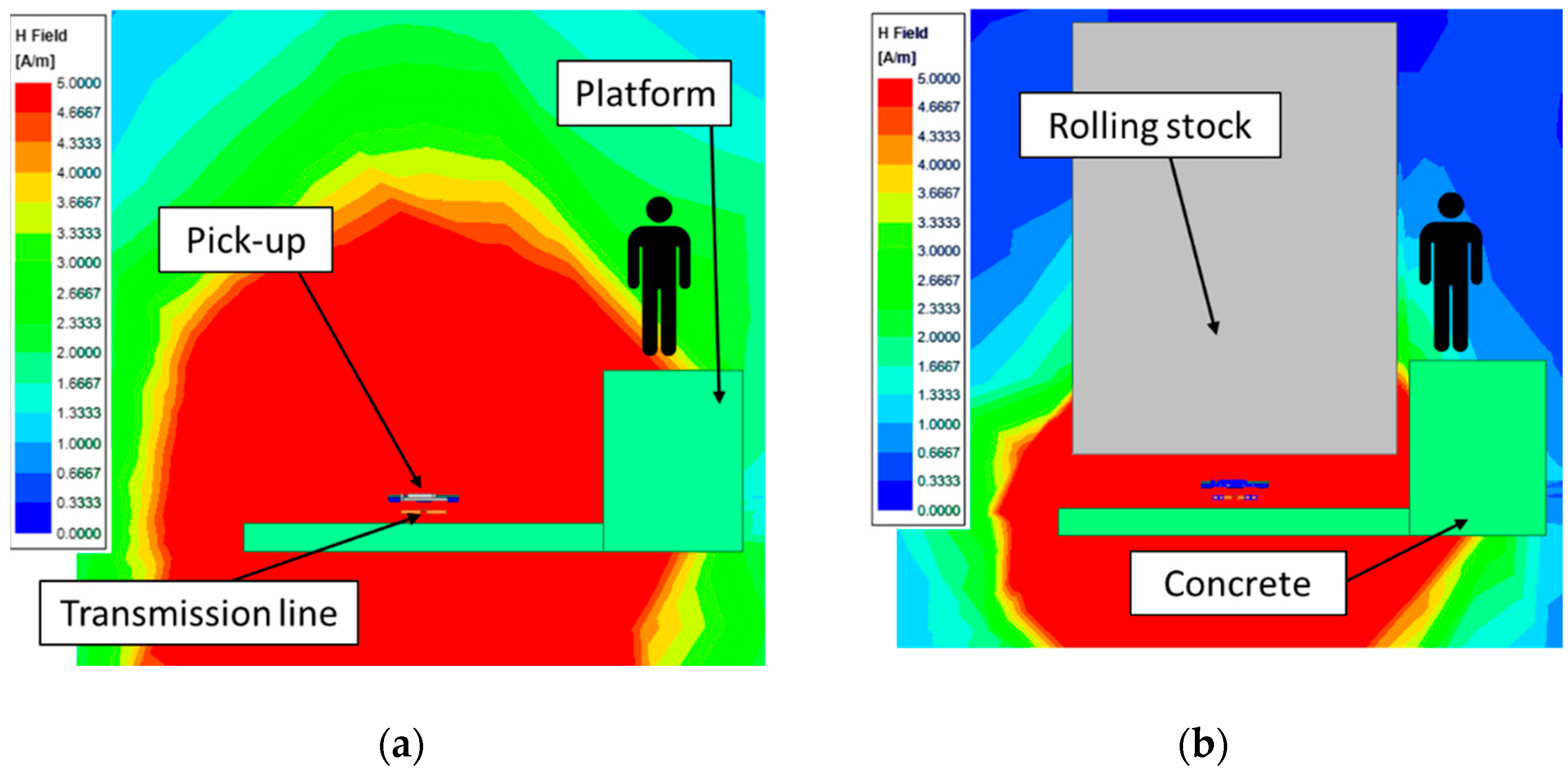
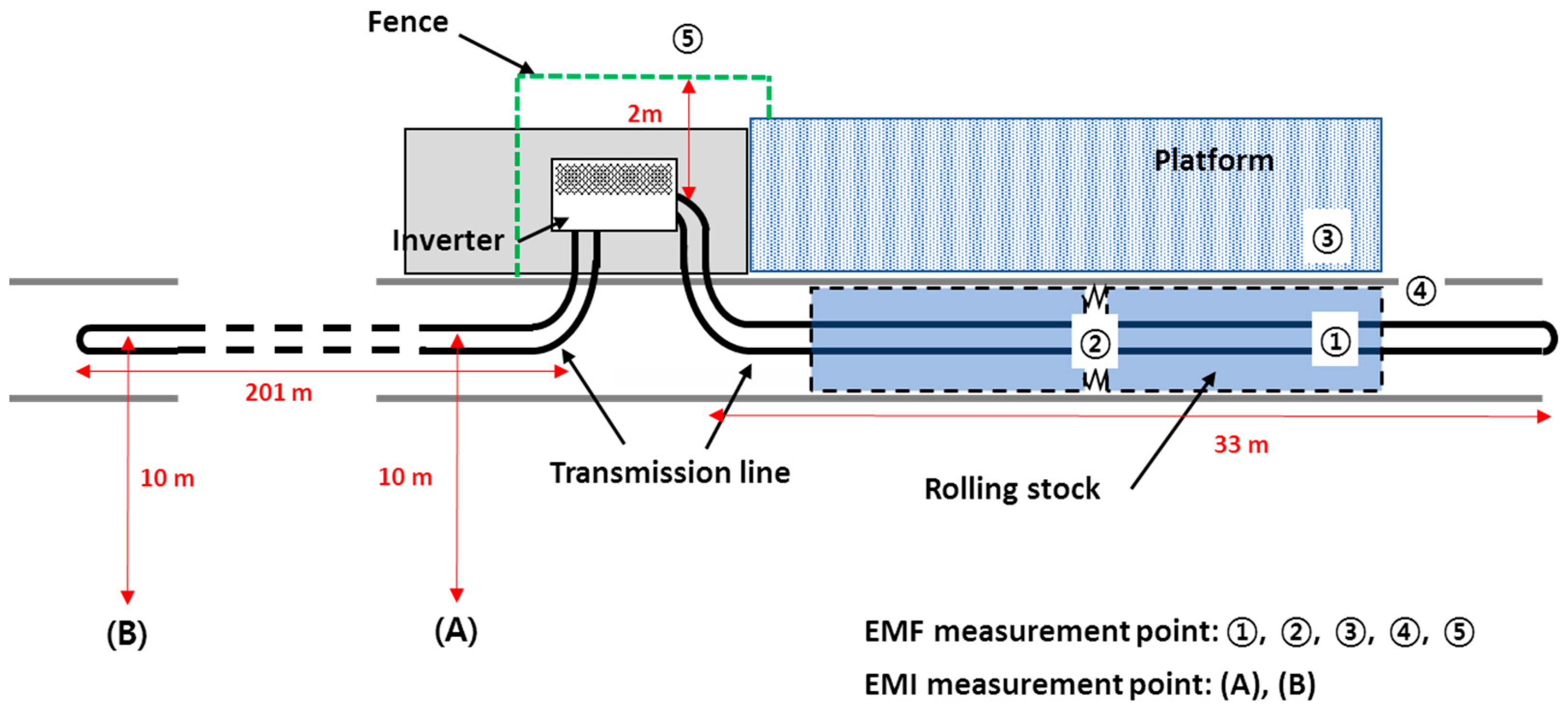
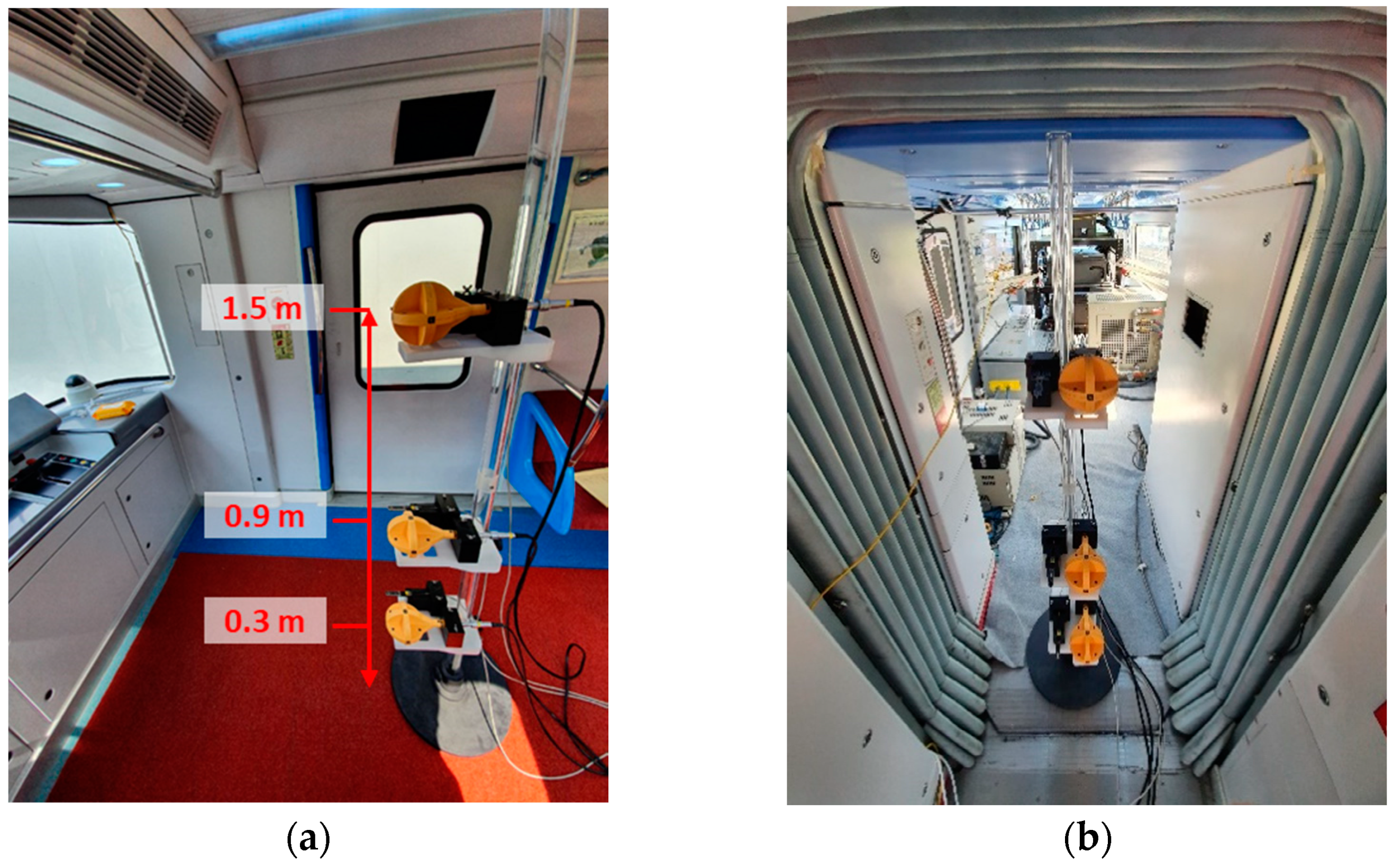
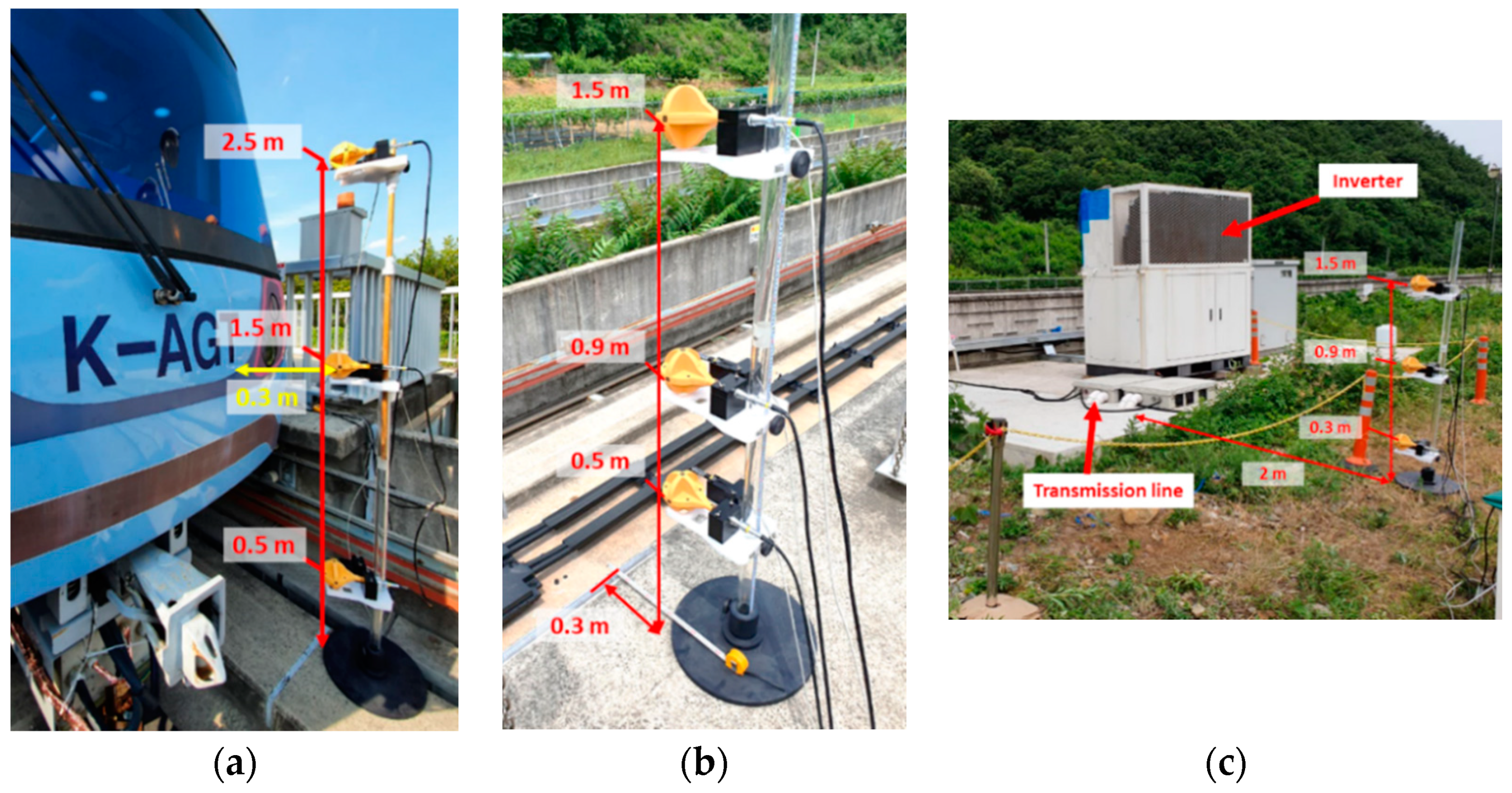
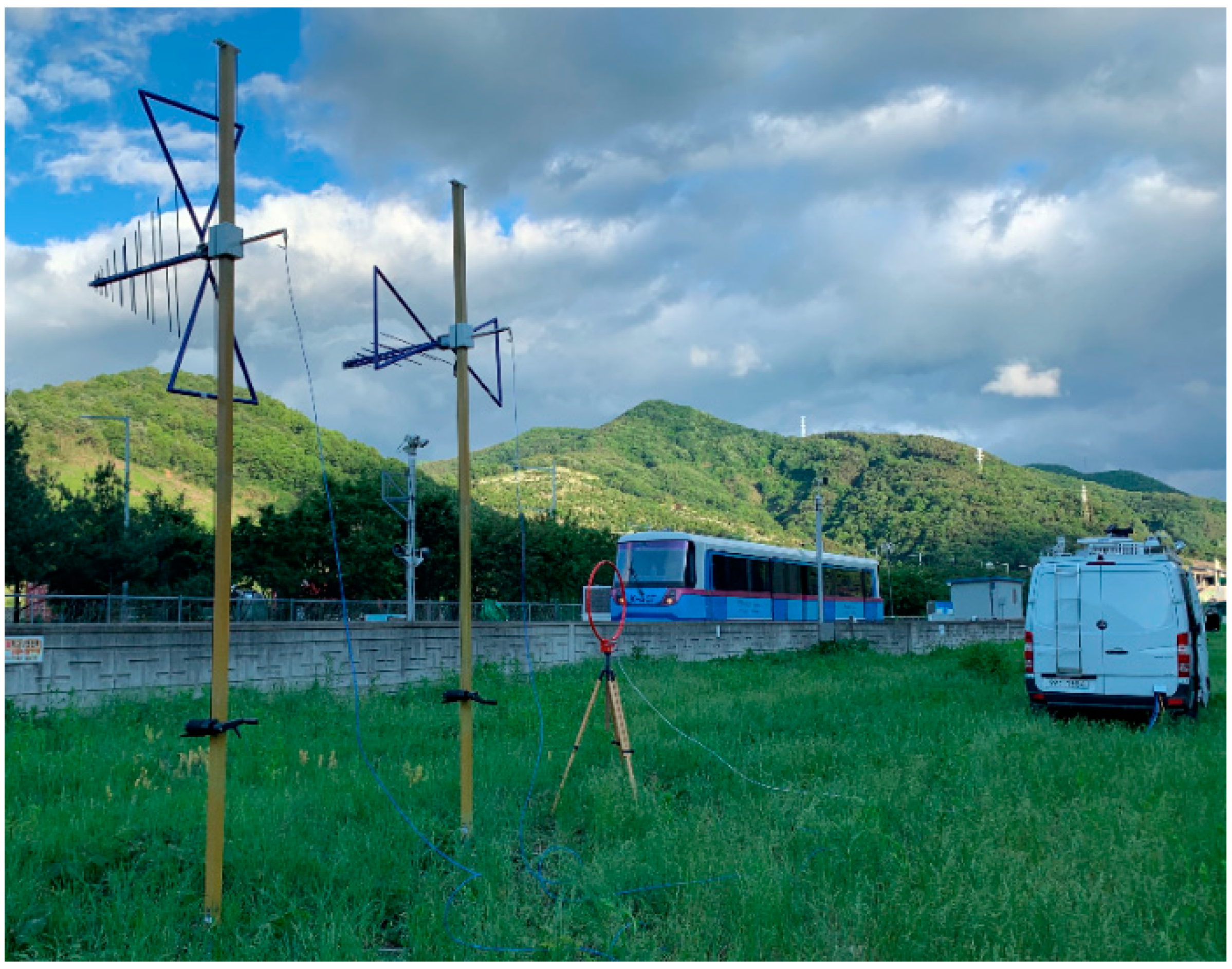
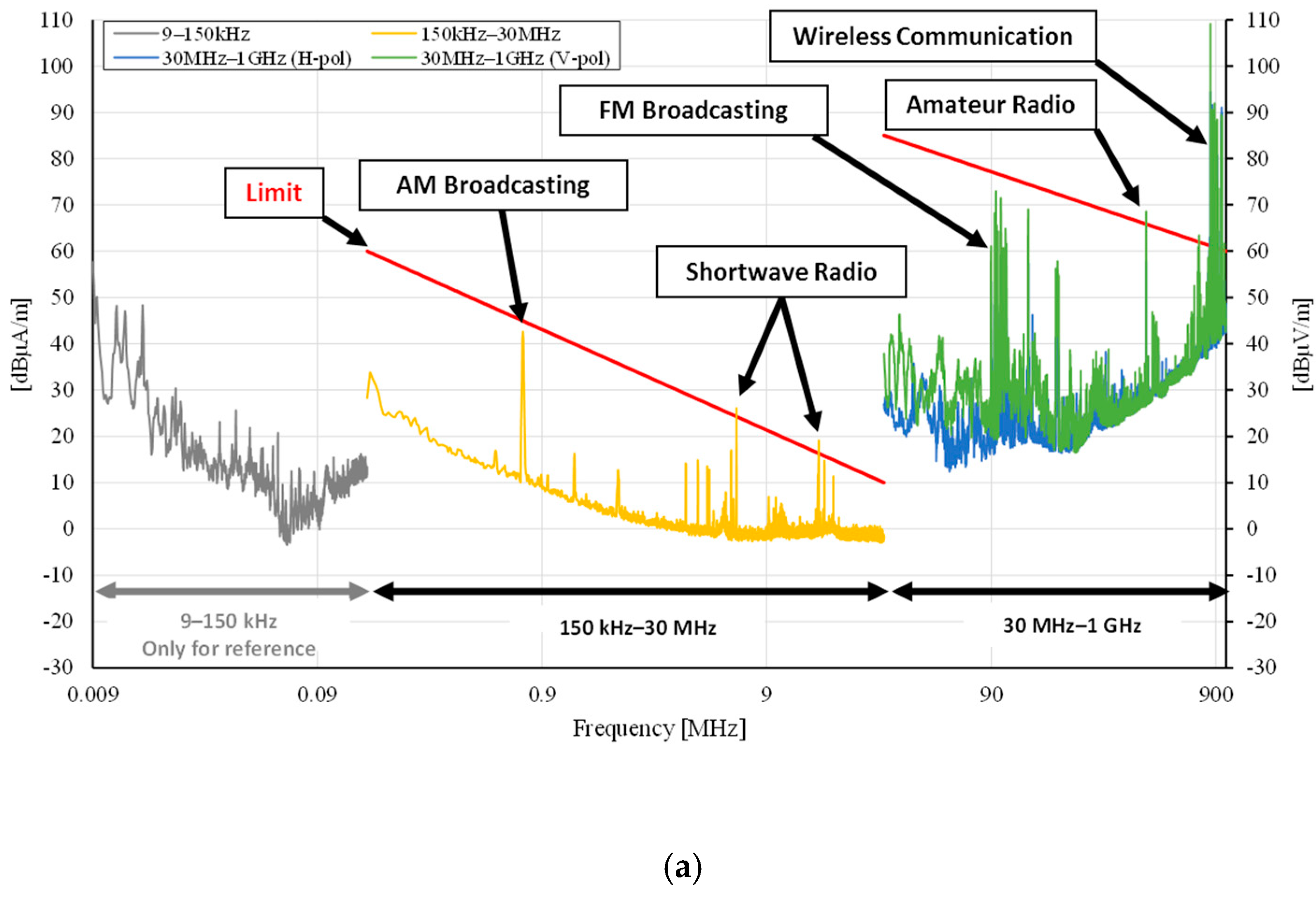
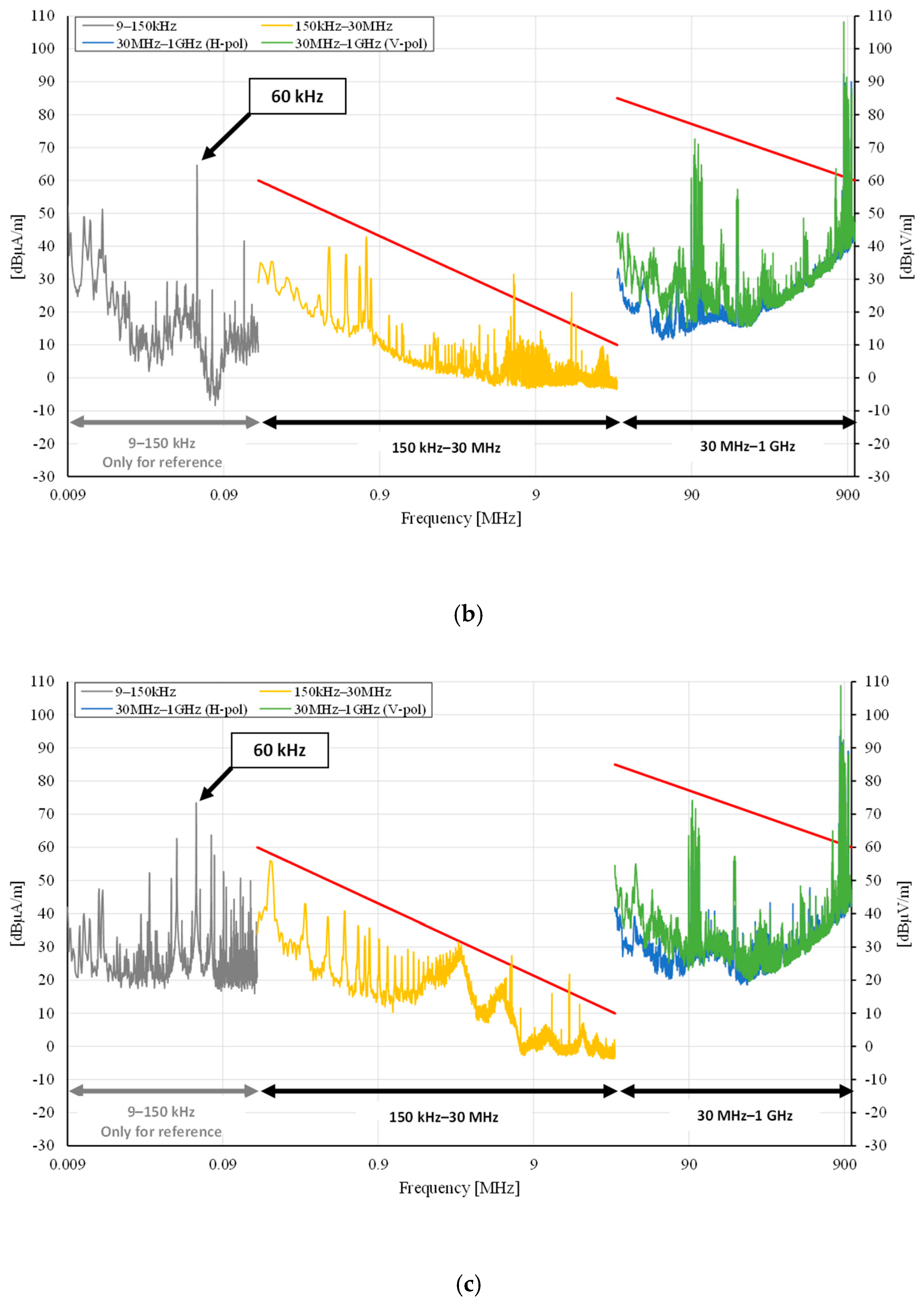
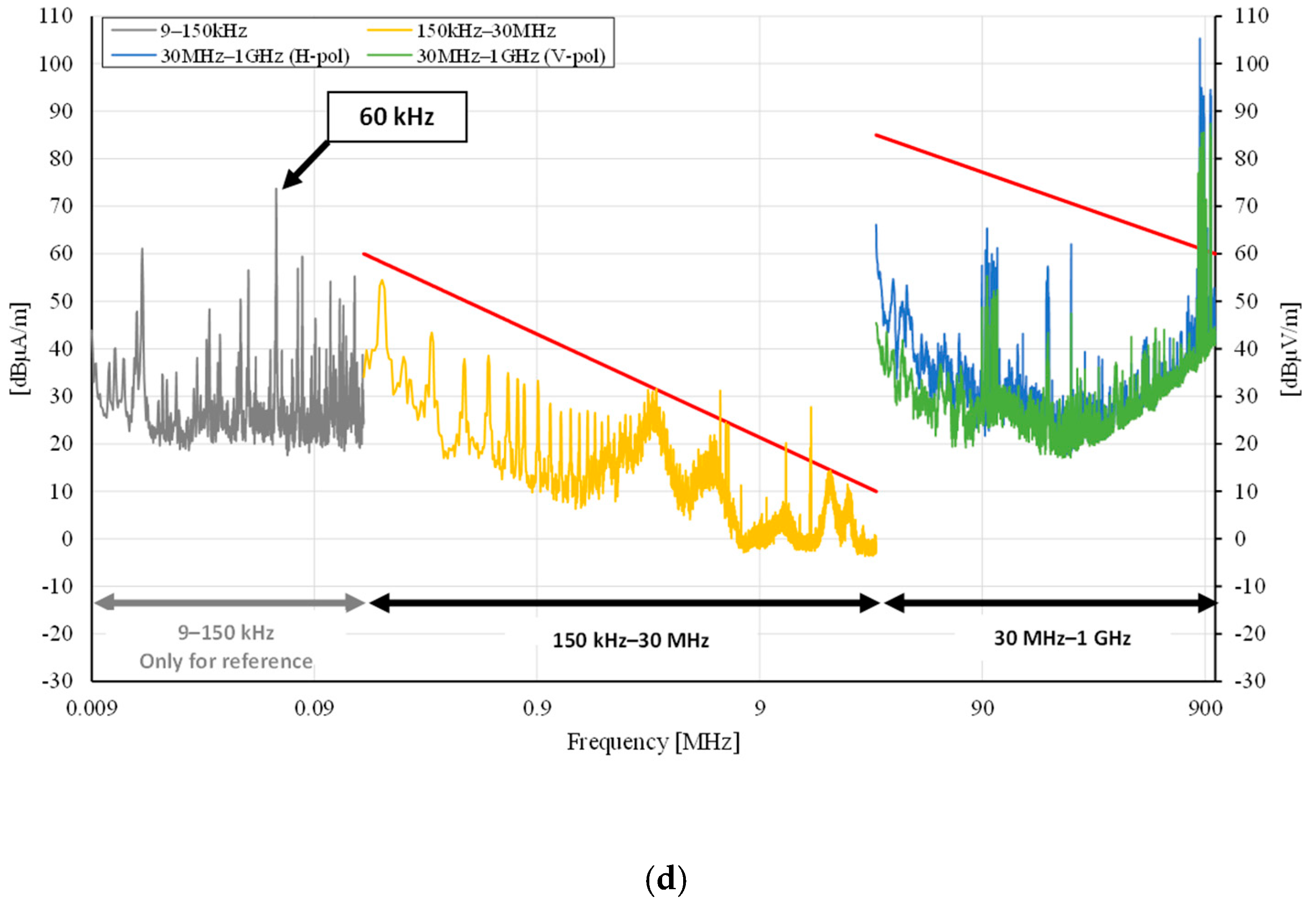
| Frequency Range | H-Field Strength (A/m) | B-Field (μT) | |
|---|---|---|---|
| ICNIRP 1998 | 3–150 kHz | 5 | 6.25 |
| ICNIRP 2010 | 3 kHz–10 MHz | 21 | 27 |
| Category | Description | |
|---|---|---|
| Frequency | 60 kHz | |
| Air gap | 60 mm | |
| Maximum efficiency | 90.1% | |
| Inverter | Maximum current | 500 A |
| Maximum output power | 1.2 MW | |
| Transmission line | Rated current | 500 A |
| Length | 201 m | |
| Pick-up | Output voltage | 750VDC |
| Output power | 250 kW/unit | |
| Measurement Points | Measurement Height | Measured B-Field (μT) (Intensity Limit: 6.25) |
|---|---|---|
| Inside the rolling stock | 0.3 m | 0.49 |
| 0.9 m | 0.45 | |
| 1.5 m | 0.33 | |
| Gangway | 0.3 m | 2.41 |
| 0.9 m | 1.90 | |
| 1.5 m | 1.78 |
| Measurement Points | Measurement Height | Measured B-Field (μT) (Intensity Limit: 6.25) | Simulated B-Field (μT) |
|---|---|---|---|
| Front of the rolling stock | 0.5 m | 14.50 | 13.88 |
| 1.5 m | 4.09 | 6.62 | |
| 2.5 m | 1.37 | 3.77 | |
| Platform | 0.5 m | 1.93 | 1.17 |
| 0.9 m | 1.48 | 1.01 | |
| 1.5 m | 1.08 | 0.73 | |
| Near the inverter | 0.3 m | 4.03 | - |
| 0.9 m | 3.98 | - | |
| 1.5 m | 1.99 | - |
Publisher’s Note: MDPI stays neutral with regard to jurisdictional claims in published maps and institutional affiliations. |
© 2021 by the authors. Licensee MDPI, Basel, Switzerland. This article is an open access article distributed under the terms and conditions of the Creative Commons Attribution (CC BY) license (http://creativecommons.org/licenses/by/4.0/).
Share and Cite
Lee, G.; Kim, M.Y.; Lee, C.; Jang, D.; Lee, B.-S.; Kim, J.H. Electromagnetic Field Tests of a 1-MW Wireless Power Transfer System for Light Rail Transit. Energies 2021, 14, 1171. https://doi.org/10.3390/en14041171
Lee G, Kim MY, Lee C, Jang D, Lee B-S, Kim JH. Electromagnetic Field Tests of a 1-MW Wireless Power Transfer System for Light Rail Transit. Energies. 2021; 14(4):1171. https://doi.org/10.3390/en14041171
Chicago/Turabian StyleLee, Gunbok, Myung Yong Kim, Changmu Lee, Donguk Jang, Byung-Song Lee, and Jae Hee Kim. 2021. "Electromagnetic Field Tests of a 1-MW Wireless Power Transfer System for Light Rail Transit" Energies 14, no. 4: 1171. https://doi.org/10.3390/en14041171
APA StyleLee, G., Kim, M. Y., Lee, C., Jang, D., Lee, B.-S., & Kim, J. H. (2021). Electromagnetic Field Tests of a 1-MW Wireless Power Transfer System for Light Rail Transit. Energies, 14(4), 1171. https://doi.org/10.3390/en14041171







